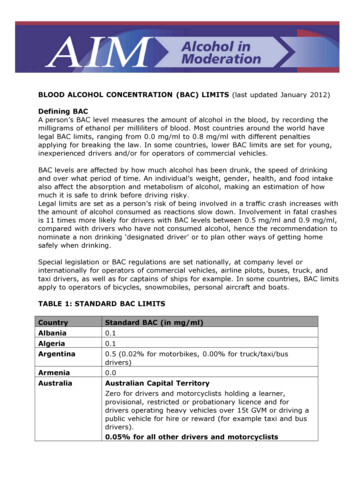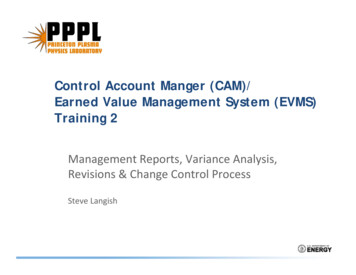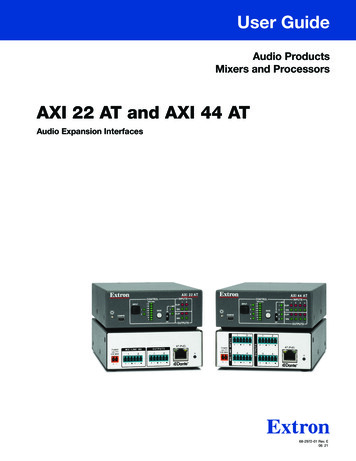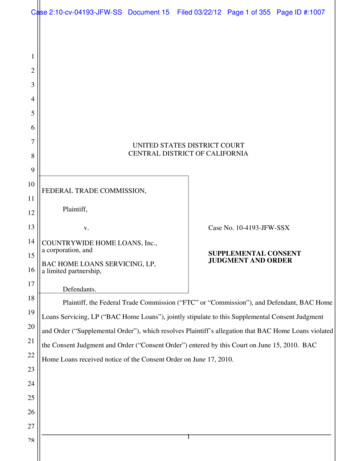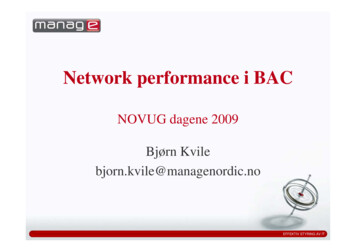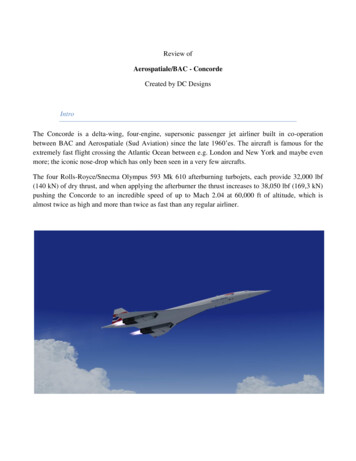
Transcription
Review ofAerospatiale/BAC - ConcordeCreated by DC DesignsIntroThe Concorde is a delta-wing, four-engine, supersonic passenger jet airliner built in co-operationbetween BAC and Aerospatiale (Sud Aviation) since the late 1960’es. The aircraft is famous for theextremely fast flight crossing the Atlantic Ocean between e.g. London and New York and maybe evenmore; the iconic nose-drop which has only been seen in a very few aircrafts.The four Rolls-Royce/Snecma Olympus 593 Mk 610 afterburning turbojets, each provide 32,000 lbf(140 kN) of dry thrust, and when applying the afterburner the thrust increases to 38,050 lbf (169,3 kN)pushing the Concorde to an incredible speed of up to Mach 2.04 at 60,000 ft of altitude, which isalmost twice as high and more than twice as fast than any regular airliner.
General Information & Aircraft Specs Produced byNational OriginFirst FlightIntroductionRetiredRoleProducedBuiltPrimary UsersStatusBAC / AérospatialeUnited Kingdom & FranceMarch 2nd 1969January 21st 1976October 24th 2003Supersonic Transport (Commercial Airliner)1965 - 197920British Airways and Air FranceRetired CrewCapacityLengthHeightWingspanWing AreaEmpty WeightGross WeightMTOWFuel CapacityPower Plant3 (two pilots and one flight engineer)92-120 passengers (128 in high-density layout)202 ft 4 in (61.66 m)40 ft 0 in (12.2 m)84 ft 0 in (25.6 m)3,856 sq ft (358.25 m2)173,500 lb (78,700 kg)245,000 lb (111,130 kg)408,000 lb (185,070 kg)210,9840 lb (95,680 kg)4x Rolls-Royce/Snecma Olympus 593 Mk610 afterburning turbojets Max SpeedCruise SpeedRangeService CeilingRate of ClimbRunway Req.Fuel Cons.Thrust/Weight1,354 mph (2,179 km/h / 1,176 knots)1,340 mph (2,158 km/h / 1,164 knots)4,488.04 miles (7,222.8 km / 3,900 nm)60,000 ft (18,300 m)3,500-5,000 ft/min (17-25 m/s) at sea level11,800 ft (3,600 m)46.85 lb/mile (13.2 kg/km)0,373
Purchase, Download and InstallationI got this add-on directly at www.JustFlight.com and the download went perfectly with ease andwithout any issues what so ever. The entire download was completed within a few seconds due to asuperb connection to the download server. The file downloaded is a zip-file containing the installer of177Mb – the installer is named ‘Install DCD Concorde 101.exe’ and features a very user friendlyinstallation wizard.Installing the Concorde was quickly completed and the amount of space used after the installation wascompleted, was only about 507Mb which is quite fair for an aircraft of this level and complexity.During the installation you get the possibility to select if the aircraft should be installed directly into theP3D main folder or if you would rather have it installed outside the P3D main folder. According to LMthey do recommend to install the aircrafts outside the main P3D folder, and therefore I selected thatoption. The add-on was now installed on the following path as a standard:C:\Users\’My Name’\Documents\Prepar3D v4 Add-ons\DCD ConcordeThe installer features several installers where you can select either FSX, FSX Steam, Prepar3Dv1, v2,v3, v4 and v5 providing this purchase to be used on multiple platforms which is really awesome.After the installation was completed I quickly entered the virtual hangar to verify that the installationhad completed with success. In the virtual hangar I found the Concorde perfectly placed under thefollowing headers:Vehicle Title Concorde, Publisher DC Designs and Manufacturer Aerospatiale/BACThere were a total of 4 liveries included in the package featuring two British Airways liveries whereone was the 1990 and the other was the 2000. Furthermore there was one Air France livery togetherwith one Singapore Airlines 1977 livery. All liveries look great and are perfectly represented in thevirtual hangar.Included in the add-on are also a very comprehensive 65 pages PDF manual as well as two ratherimportant links to different .htlm locations. The first is DCD Concorde Check.htlm – this link takesyou to a simplified procedures list of the various stages of flying the Concorde, from pre-engine start toafter landing. This list is extremely simplified but still provides a nice overview before digger deeperinto the manual for a more detailed description of each stage of flight.The other link is the DCD Concorde Ref.htlm which is a short list of the various reference speeds putinto a short table providing a good and easy overview.
Coming back to the included manual – this manual is absolutely recommended to read carefully or atleast skim before going for the first flight. You will find a lot of very useful information, detaileddescriptions of the various stages of flight as well as the various instruments found on the captains, thefirst officers as well as the flight engineers side. The Concorde was indeed a very complex aircraft tofly and required a 3-man flight deck where everyone had much to do especially during climb sequence.Overall the manual includes an introduction, a walk-around, a guide to the flight deck, a systems guide,a general description of how to fly the Concorde and a guide to flight planning. The manual is verywell written and easy to understand even for people like me which do not have English as their primarylanguage. There are lots of pictures providing a really good understanding of what is written and whenyou have gone though the entire manual (takes about half an hour), you will have a basic understandingand knowledge of how the Concorde works as well as some specific information about take-off, climband landing speeds.All stages of flight are perfectly and in great detail described in the manual as well as a superbdescription of each critical instrument – here e.g. the fuel transfer function which is very important tokeep the correct center of gravity during climb and increase of airspeed.As previously stated, the Concorde is a very complex aircraft, and this simulation is also quite complexhowever, DC Designs has eased up the complexity for the simmer in several areas, so that you can alsobe able to simply enjoy the aircraft without performing a 3-man job. In general when viewing the entirecockpit – if you have some annunciators that are turned on, something is not right and on the otherhand if there is no annunciators turned on, everything is most likely going well.Included in the add-on there is also a paint-kit, providing a possibility for the simmer to also create hisor hers own liveries. Awesome!When you have loaded the Concorde for a flight, you will be able to use the created hot-keys using the‘Shift number’ keys. E.g. ‘Shift 1’ opens up a window featuring the radio stack and ‘Shift 2’ opensup a window with the default P3D GPS.
ExternalI started my test of the Concorde by performing a pre-flight inspection – walking around the aircraft toget a full view of the model itself and this was just awesome – I have for a long time wanted a highquality Concorde for P3Dv4 and now I was actually performing the walk-around.The model is absolutely stunning and resembles the real Concorde beautifully. The aircraft appearsvery authentic and almost majestic with all of its unique characteristics such as the tall landing gear, theslim fuselage, the delta wings and the pointy nose that just screams ‘high-end aerodynamics’. I wasindeed very impressed with what I saw and to top it off, the iconic visor and nose-drop was also a partof this model which was just the cream on top.The textures used on the Concorde are high quality, multi-layer textures, that provides the visibleappearance of the aircraft to be shiny and newly polished without much wear and tear. Since theConcorde is a rather old bird I would have loved to also see a livery featuring textures showing the ageof the aircraft with a certain degree of wear and tear, but that is just my opinion.There are several animations included in the model. The most iconic animation is the famous nose-dropwhich has been animated using a total of four different steps. Step one is fully retracted; step two isvisor down; step three is nose down by 5 degrees and the final step is step four which is nose all theway down to 12,5 degrees. The motion is smooth for each step and absolutely creates a realisticexperience.Other animations are such as gear up/down, gear suspension, gear-bay doors open/close, the variouscontrol surfaces (rudder, ailerons and elevator), reverse thrusters, engine blades rotating, main dooropen/close, wheels rotating and nose wheel turning/steering etc. All animations are like the nose dropwith a smooth motion and very realistic. Since there are no flaps on the Concorde, the flaps animationis not included. I did notice that the engine exhaust blades did not move according to the throttle inputwhich I think is a bit strange however, they did move when activating the reverse thrusters.There are also various effects included like the beautiful afterburner flame effect which glows with ahot and realistic flame however, it seems that there is only one level of the flame effect. I am not sure ifthere in real life would be several levels according to the throttle setting but I would assume so. Neverthe less the flame effect is beautiful and certainly adds to the realism of this aircraft.During engine start-up, there is also a smoke effect consisting of first a small burst of black smokequickly replaced by a 2 seconds burst of white dense smoke. Nice smoke effect.You also have a complete set of lights on the aircraft like the anti-collision lights, the beacon, and thenavigation lights as well as logo, taxi and landing lights. Additionally the cabin and cockpit lights arealso visible from the outside of the aircraft. However, I could not find the beacon light on the model
itself but when I turned on the beacon when the aircraft was on the ground, I could see the reflection onthe ground, so yes it is included. Furthermore I could not get the taxi lights or the logo lights to workeven though I turned them on in the cockpit. I do not know if that is due to me doing somethingincorrectly or if these lights are just not applied to the simulation.The landing lights are perfectly working and you find one on each side of the fuselage just in front onthe wings and another two landing lights mounted on the nose-wheel. The landing lights are verypowerful and illuminate the ground perfectly with a bright and clear shine.The Anti-Collision lights are placed with one on each forward wing root flashing a bright white shineand one placed on the far back-end of the tail flashing a bright red shine. The Navigation lights areplaced with two on each wing – a set placed together with the Anti-Collision lights on the forward wingroot and one on each wing placed far back on the wing with the colors red for left side and green forright side. Also, there is placed one Navigation light at the far back-end of the tail combined with theAnti-Collision light there – the shine from this light is a clear white shine.I did several pre-flight inspections of this aircraft, and one of the best was an early summer morning atPANC where the morning sun-rays was glaring off the newly polished fuselage and wings in a mostbeautiful and stunning way – the experience here was so exceptional, stress-less, calm and beautifuland it just increased my experience of this aircraft so much pre-paring for a flight between Anchorageand Honolulu.
InternalAfter the pre-flight inspection was passed with success I now walked into the cockpit and sat down inthe captain’s seat for a look-around. The cockpit environment is really well made with a full 360degrees virtual cockpit featuring both pilot seats as well as the flight engineer’s seat behind the F/O.When you sit in the cockpit of the Concorde and let your eyes wander around, you are immediatelytaken back in time. All the old steam gauges and the overall old fashioned analogue cockpit layout istruly a fascinating and exciting experience – I just love it!The cockpit is filled with unique details to make sure that you really feel like being inside the realConcorde and DC Designs has succeeded greatly. The textures used are good quality multi-layertextures showing off the cockpit as being old and used with a good degree of wear and tear as whichcan be found all around the cockpit environment. The finish is okay and you get a very realisticexperience in the cockpit, but there is space for improvements e.g. making the textures more crisp andso in my honest opinion.One thing that I also noticed was the scratches on the windshield – that is just awesome and provides asuperb authenticity to this old bird. Also there are several dark shadows at e.g. the autopilot to indicatewear and tear from the many years in service as well as edges all around the cockpit that are created sothat the edge looks like it has been touched many times, or that paint has even been worn off –Absolutely awesome details.There are lots of animations as e.g. the various needles in the old gauges, but also animations for thevarious levers, the yokes, the rudder pedals and all the various switches and buttons which are found inhuge numbers around this old time cockpit. All animations are very life-like and created with a smoothmotion.The atmosphere created in the virtual cockpit is superb and combining the virtual cockpit with thecorresponding sound set, you certainly have a perfect setup for a great and very realistic atmosphere fore.g. a long-.haul flight with this iconic bird.The depth-performance (3D visuals) is perfect; the systems are working and have been created to easethe pilots work load instead of being 100% - this I do like very much because I normally fly alone andfind it more than just a heavy task to fly a regular airliner and here not to mention, I also would have todo the flight engineer’s workload, so I am very pleased with the systems programming. The systemsare fair and have a good in-depth structure but still durable for a single person to fly, monitor andexecute changes throughout the entire flight.Overall a really good quality virtual cockpit that provides the simmer with an exceptional flightsimulation experience.
SoundThere are several sound sets included in this add-on. First you have the engine sound set which consistsof a complete set covering everything from engine start-up to engine shutdown also including all thevarious rpm settings in between.The engine sound set is awesome with a nice spool and pitch of the engine sound as the rpms areincreasing as well as a huge roar when applying the afterburner for takeoff – this is especially loudwhen heard from the external view. However, when listening to the engine sound from the cockpit, thesound is actually very low volume and I had to turn up my volume to get to hear the engines from thecockpit. Unfortunately by doing so, all other environmental sounds in the cockpit were also affectedand were now way too loud – this I might be able to customize in the main P3D settings menu, but thenit will affect all other add-ons as well.Maybe the volume of the engine sound is very much in accordance to real life – this I don’t know andcannot confirm. It could make sense since the engines are all placed as far back and away from thecockpit as possible and the afterburner roar normally is louder behind the aircraft, but I am still missingsome more engine sound in the cockpit as a personnel preference.Secondly there are various environmental sounds in the cockpit like the movement of levers, clickingswitches or rotating encoders, movement of the visor and nose etc. You can also hear the wind on thewindshield when the visor is lowered – really nice detail.All sounds are high quality and crystal clear and the various sound sets fits perfectly to the add-on andprovides the simmer with an enhanced simulation experience – Only thing that I was missing was thechimes/call-outs like e.g. overspeed warning, stall warning and coming in for landing with the 50, 40,30 I don’t know if the real Concorde had these call-outs but nevertheless there were none included.One thing that could be awesome is if there was also a sound set covering fictive correspondences tothe passengers from the flight deck and/or in-between the flight deck and the ATC during variousstages of flight or maybe just some general cockpit noises. just ideas.I tested the sounds using first ordinary stereo, then a 2.1 setup featuring two front speakers and anactive sub, and finally a complete 7.1 surround sound setup. The sound performed perfectly in allsetups.
Flight Dynamics and CharacteristicsTest flying the Concorde was absolutely extremely exhilarating and some of the most interesting testflights that I have performed in a long time. The Concorde is a very different aircraft to both handle onthe ground but also to fly and especially to land – here e.g. you have no flaps to provide more lift and aslower landing speed and the cockpit is placed very high up above the runway even at touchdownwhich does provide some challenges for the pilot.I started my first test flight by getting into the captain’s seat, getting comfortable and then powering upthe four Rolls-Royce engines before starting the taxi to the active runway. The view from the cockpit isa really good panoramic view when the visor and the nose are down and then quite the opposite whenthe visor and nose is up providing a very limited view straight forward.To get the Concorde moving requires that you do throttle up a bit, but as soon as the aircraft starts toroll, you can easily reduce power to almost idle and the Concorde will continue with a fair taxi speed.One of the major challenges I found taxiing the Concorde, was that even though the nose-wheel canturn the Concorde on a very small radius, turning the Concorde from one taxiway to another and so on,was certainly something that I had to get used to. I have previously taxied many different heavyairliners, but somehow taxiing the Concorde was very different – the cockpit placement is so far infront of the nose-wheel meaning that to keep the Concorde on the taxiway and performing e.g. a 90degree turn, would result in the cockpit being almost at the edge of the taxiway or even over the grassnext to the taxiway before I could turn the nose-wheel. That was certainly something that I had to getused to, but I did however quickly learn it and also found that turning the nose-wheel was a verysmooth motion which made it a whole lot easier.The wheel brakes when taxiing the Concorde are very efficient when the surface is hard like concreteor asphalt or similar, but when taxiing over a softer surface like grass, the efficiency decreases rapidly.I know that in real life you would not taxi the Concorde over e.g. grass, but I just had to try it and see ifthere were any differences. Performing a rapid braking on the runway where you also apply the reversethrusters, provides a very strong and efficient decrease of speed – this really does comes in handy whentrying to land the Concorde and you don’t touchdown until you are very far down the runway.Lining up on the runway for takeoff and pushing the throttle to maximum, the Concorde acceleratesfaster than a normal airliner and is still very steady and easy to control during the entire takeoff roll. Ofcourse taking off in windy conditions will affect the aircraft, but actually not that much – this isprobably due to the limited size of the vertical stabilizer. Reaching V1, V2 and Rotate speed, I startedto lift the nose to an angle of about 12 degrees and the Concorde nicely lifted off the ground. Afterbeing airborne I felt the Concorde to still be very steady and easy to maneuver – In general I felt theConcorde to be super smooth on the controls and not over-sensitive providing a good sturdy feel of the
aircraft. The climb ratio just after the aircraft has lifted off the ground is not high, the first 1,000’ doestake some time, but thereafter it climbs like an arrow.Flying the Concorde by the numbers can be very challenging but fortunately in a simulation you canexceed some of the boundaries. I do try making every flight as realistic as possible, but that said, I didseveral times exceed Mach 1 over land areas which I know is not allowed in real life. One of the veryinteresting parts of flying the Concorde is the climb to cruising altitude – you can fly the Concordeusing either the auto-pilot, which by the way is fairly simple and intuitive – quite advanced for its timeactually, or you can fly it manually. When you reach an altitude of about 34,000’ you normally wouldreach your cruising altitude, this however is not the scenario for the Concorde – here you continue theclimb up until you reach an altitude of about 55,000’ – 60,000’ and up here you have a superb viewlooking down on the regular airliners cruising at about just half your altitude. The sky is very differentup here – more dark and I would assume that you in real life would be able to see the curvature of theearth – this is not that visible in the simulator however.I climbed the Concorde all the way up to 60,000’ just to verify that this can actually be performed inthe simulation. Here I also checked the IAS to see if the Concorde was also able to reach Mach 2.04and this it certainly was. To see these two performance specs being a part of the simulation, justimproved the experience of realism of flying this bird greatly.Now I set my focus on stalling the Concorde – first I tried a straight out stall and what I discovered wasthat the aircraft didn’t seem to stall as I thought it would. The IAS was decreasing and my pitch angleincreasing but somehow I was still able to fairly control the aircraft. It became very wobbly and I couldsee that my VSI showed more and more negative numbers as well as the ALT was suddenly rapidlydecreasing – no stall warning, no shake effect to alert the pilot, actually nothing else but the VSI, theALT and the IAS indicating that I was now falling out of the sky in a very controllable manner. I amnot sure this is realistic, but then again, this I of course cannot verify since I have never flown theConcorde myself in real life.Stalling the Concorde with a positive pitch angle and with a bank angle of 30 degrees was a differentexperience. Now I felt the Concorde becoming quite difficult to control as well as loss of lift on thestalled wing resulting in high bank angles and a very wobbly flight experience. That is probably morerealistic in my opinion. Lowering the visor and nose did not have any visible impact on the IAS which Iwould have assumed, since the nose drop would result in more drag – however lowering the landinggear did have a visible impact on the IAS which is perfect.Landing the Concorde is much different from landing other heavy aircrafts – the high pitch anglemakes the approach and final very challenging and it almost feels like you are stalling the aircraft allthe way down to touchdown simply because you really feel this pitch angel and it seems just wrong.But I of course managed to learn it and I am totally in love with the Concorde.
ConclusionTo wrap up my experience of this awesome old classic bird created by DC designs, then this is mostcertainly a high quality add-on featuring various unique and distinctive details and characteristics andthe authenticity of the Concorde is superb. The model is very beautiful and created with great focus onrealism and covered with high quality multi-layer textures showing off the model perfectly.There are included a complex but still manageable virtual cockpit featuring the captain’s seat, the firstofficer’s seat as well as the flight engineer’s seat. On all stations you have working systems, movablelevers, push-able buttons etc. to create the best and most authentic cockpit experience. The virtualcockpit is a complete environment in which DC Designs has created the systems to ease the pilotworkload in several scenarios and the layout is a beautiful old fashioned steam gauges layout with noglass cockpit as per real life. The textures in the virtual cockpit are high quality and provide the virtualcockpit with a realistic touch of being an old fashioned airliner with a good degree of wear and tear allover.The sound set is a complete set of both engine and environmental sounds – all sounds are high qualityand absolutely very realistic. I did miss some chimes as stall warning, overspeed warning and landingcall-outs, but I cannot verify if they were actually part of the real Concorde or if they are indeedmissing from this add-on.You don’t need a high-end system to fly the Concorde and to get a superb experience – the FPS is goodand the Concorde did not impact my systems FPS as far as I could see.Overall a superb rendition of this classic bird which I absolutely can recommend – If you like airlinersand also like to fly fast and high, then this is an add-on that you must have. The Concorde created byDC Designs scored an awesome 4.61 out of 5 – a great thanks to the people behind DC Designs toprovide the community with this beautiful and excellent add-on. You have done a superb job oncreating the Concorde.Rays Aviation
Technical Requirements and Review Computer SpecificationsSystem Requirements (Minimum) Platform P3Dv1-v5 or FSX/FSX Steam2.0GHz or any Dual Core2GB RAM1GB Graphics CardWindows 10 / 8 / 7 – both 32 and 64-bit474MB Available HDD-SpaceReview Computer Specifications Windows 10 (64-bit)Windows 7 (32-bit) (secondary system)Intel Core i7-4790K 4x4.00GHz (Turbo 4x4.40GHz)Asus Maximus VII Ranger (ROG-series)Antec Kuhler H20 650 Water CoolerKingston HyperX Beast-series 32Gb DDR3-2133 RAM500Gb Samsung 850 EVO SSD3Tb Seagate Barracura (7200rpm, 6Gb/s)Asus GeForce GTX 980 Strix OC 4Gb150/150Mbit Fiber Internet ConnectionPrepar3D v4.5REX SkyForce 3D
Aerospatiale/BAC - Concorde Created by DC Designs Intro The Concorde is a delta-wing, four-engine, supersonic passenger jet airliner built in co-operation between BAC and Aerospatiale (Sud Aviation) since the late 1960'es. The aircraft is famous for the extremely fast flight crossing the Atlantic Ocean between e.g. London and New York and .


